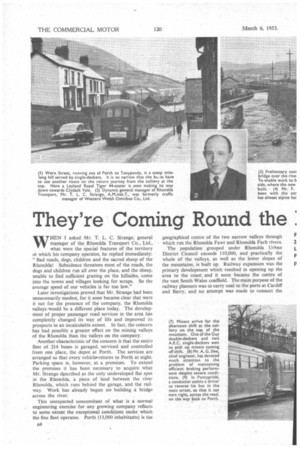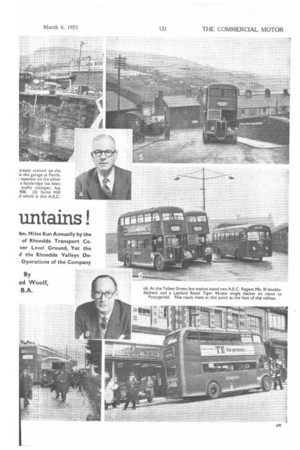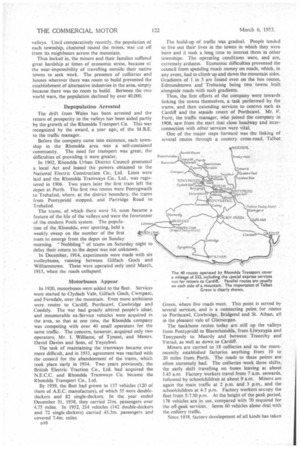They're Coming Round the untains
Page 48

Page 49

Page 50

Page 51

If you've noticed an error in this article please click here to report it so we can fix it.
4m. Miles Run Annually by the of Rhondda Transport Co. ver Level , Ground, Yet the if the Rhondda Valleys De. Operations of the Company
By ed Woolf, B.A. WHEN I asked Mr. T. L. C. Strange, general manager of the Rhondda Transport Co., Ltd., what were the special features of the territory in which his company operates, he replied immediately: "Bad roads, dogs, children and the sacred sheep of the Rhondda! Subsidence threatens most of the roads, the dogs and children run all over the place, and the sheep, unable to find sufficient grazing on the hillsides, come into the towns and villages looking for scraps. So the average speed of our vehicles is far too low."
Later investigations proved that Mr. Strange had been unnecessarily modest, for it soon became clear that were it not for the presence of the company, the Rhondda valleys ivouId be a different place today. The development of proper passenger road services in the area has completely changed its way of life and improved its prospects to an incalculable extent. In fact, the concern has had possibly a greater effect on the mining valleys of the Rhondda than the valleys on the company.
Another characteristic of the concern is that the entire fleet of 214 buses is garaged, serviced and controlled from one place, the depot at Porth. The services are arranged so that every vehiclepreturns to Porth at .night. Parking space is, however, at a premium. To extend the premises it has been necessary to acquire what Mr. Strange dgscribed as the only undeveloped fiat spot in the Rhondda, a piece of land between the river Rhondda, which runs behind the garage, and the railway. Work has already begun on building a bridge across the river.
This unexpected concomitant of what is a normal engineering exercise for any growing company reflects to some extent the exceptional conditions under which the fine fleet operates. Porth (13,000 inhabitants) is Inc geographical centre of the two narrow valleys through which run the Rhondda Fawr and Rhondda Fach rivers.
The population grouped under Rhondda Urban District Council exceeds 110,000, and practically the whole of the valleys, as well as the lower slopes of the mountains, is built up. Railway expansion was the primary development which resulted in opening up the area to the coast, and it soon became the centre of the vast South Wales coalfield. The main purpose of the railway planners was to carry coal to the ports at Cardiff and Barry, and no attempt was made to connect the valleys. Until comparatively recently. the population of each township, clustered round the mines, was cut off from its neighbours across the mountain.
Thus locked in, the miners and their families suffered great hardship at times of economic stress, because of the near-impossibility of travelling outside their native towns to seek work. The presence of collieries and houses wherever there was room to build prevented the establishment of alternative industries in the area, simply because there was no room to build. Between the two world wars, the population declined by over 40,000.
Depopulation Arrested
The drift from Wales has been arrested and the return of prosperity to the valleys has been aided partly by the growth of the Rhondda Transport Co. This was recognized by the award, a year ago, of the M.B.E. to the traffic manager.
Before the company came into existence, each township in the Rhondda area was a self-contained ' community. The need for transport was great; the difficulties of providing it were greater.
In 1902, Rhondda Urban District Council promoted a local Act and leased the powers obtained to the National Electric Construction Co., Ltd. Lines were laid and the Rhondda Tramways Co., Ltd., was registered in 1906. Two years later the first tram left the depot at Porth. The first two routes were Pontygwaith to Trehafod, where, at the district boundary, the trams from Pontypridd stopped, and Partridge Road to Trehafod.
The trams, of which there were 54, soon became a feature of the life of the valleys and were the forerunner of the modern Pools system. The population of the Rhondda, ever sporting, held a weekly sweep on the number of the first tram to emerge from the depot on Sunday morning. " Nobbling " of trams on Saturday night to delay their return to the depot was not unknown.
In December, 1914, experiments were made with six trolleybuses, running between Gilfach Goch and Williamstown. These were operated only until March, 1915, when the roads collapsed.
Latest
Motorbuses Appear In 1920, motorbuses were added to the fleet. Services were started to Clydach Vale, Gilfach Goch, Cwmparc, and Ferndale, over the mountain. Even more ambitious were routes to Cardiff, Porthcawl, Cowbridge and Coedely. The war had greatly altered people's ideas, and innumerable ex-Service vehicles were acquired in the area, so that at one time, the Rhondda company was competing with over 40 small operators for the same traffic. The concern, however, acquired only two operators, Mr. 1. Williams, of Tynant, and Messrs. David Davies and Sons, of Ynysybwl.
The task of maintaining the tramways became ever more difficult, and in 1933, agreement was reached with the council for the abandonment of the trams, which took place early in 1934. Two years previously, the British Electric Traction Co., Ltd. had acquired the N.E.C.C. and Rhondda Tramways Co. became the Rhondda Transport Co., Ltd.
By 1939, the fleet had grown to 137 vehicles (120 of them of A.E.C. manufacture), of which 55 were doubledeckers and 82 single-deckers. In the year ended December 31, 1938, they carried 21m. passengers over 4.75 miles. In 1952, 214 vehicles (142 double-deckers and 72 single-deckers) carried 43.3m. passengers and covered 7.4m. miles.
o10 The build-up of traffic was gradual. People tended to live out their lives in the towns in which they were born and it took a long time to interest them in other townships. The operating conditions were, and are, extremely arduous. Economic difficulties prevented the council from spending much money on roads, which, in any event, had to climb up and down the mountain sides. Gradients of 1 in 5 are found even on the bus routes, Edmundstown and Trebanog being two towns built alongside roads with such gradients.
Thus, the 'first efforts of the company were towards linking the towns themselves, a task performed by the trams, and then extending services to centres such as Cardiff and the seaside resort of Porthcawl. Mr. F. Fortt, the traffic manager, who joined the company in 1908, saw from the start that close headway and interconnection with other services were vital.
One of the major steps forward was the linking of several routes through a country cross-road, Talbot Green, where five roads meet. This point is served by several services, and is a connecting point for routes to Porthcawl, Cowbridge, Bridgend and St. Athan, all in the pleasant vale of Glamorgan.
The backbone routes today are still up the valleys from Pontypridd to Blaenrhondda, from Llwynypia and Tonypandy to Maerdy and between Treorchy and Ystrad, as well as down to Cardiff.
Miners are carried to 18 collieries and to the more recently established factories anything from 10 to 20 miles from Porth. The roads to these points are often extremely bad. The collieries work three shifts, the early shift travelling on buses leaving at about 5.45 a.m. Factory workers travel from 7 a.m. onwards, followed by schoolchildren at about 9 a.m. Miners are again the main traffic at 2 p.m. and 3 p.m., and the schoolchildren at 4-5 p.m. Factory workers occupy the fleet from 5-7.30 p.m. At the height of the peak period, 178 vehicles are in use, compared with 70 required for the off-E•eak services. Some 60 vehicles alone deal with the colliery traffic.
Since 1938. factory development of all kinds has taken place, especially at the trading estates of Bridgend and [reforest and in the Rhondda urban area. A further area affected is St. Athan. This development has largely been responsible for the increase of over 70 in the fleet strength, and the establishment of these estates has in turn been largely influenced by the presence of the Rhondda Transport Co., which made it possible for the factories to draw on the Rhondda valleys for their employees. The situation caused by the scarcity of building sites in the Rhondda itself, where there had been a large unemployed population from 1930, was overcome by the ability of road transport to break the mountain barriers.
Today, the valleys are busy and thriving. On market day in Pontypridd, a five-minute service of doubledeckers from Perth is inadequate; yet the narrowness of the roads, and the fact that to return to the valleys from Pontypridd it is necessary for buses to reverse in the main street of the town, makes it impossible to improve the service.
In all, Rhondda Transport operates 40 routes, with a total mileage of 532. The longest route is from Treorchy to Porthcawl, 25 miles, the fare being 3s. single and 5s. return. There are six seasonal express services, one from Ferndale to Barry Island, another seaside resort, the other five being special miners' services to Ninian Park football ground, Cardiff. These lastmentioned services are almost vital to the well-being of the country, for until they were instituted recently, miners were tempted to miss the Saturday morning shift, rather than not see the first-division football matches at
Ninian Park.
The fare scale of the company is noteworthy, for it was the first to be based on mileage, authorized by the South Wales Licensing Authority, after unfavourable comments had been passed on the anomalous situation which existed in the area. Since early February, the Rhondda company's fares have been based on Id. for journeys of half a mile, 1.8d. per mile up to 5 miles, 1.7d. per mile between 5 miles and 7.5 miles, and so on down to a minimum of 1.3d. per mile for 20 miles.
Only efficient management and a clear understanding of the needs of the area make this possible. Properly maintained vehicles are a further essential. One look at the engineering shops indicates that this requirement, too, has been fulfilled. The garage and works at Forth were built to accommodate 54 trams. Pits have been constructed in the main garage, but many of the vehicles must stand out of doors in all weathers, and there is no space for an indoor vehicle wash. Buses therefore have to be washed out in the open, with hoses and brushes. Nevertheless, the fleet has a reputation for smartness.
Of the 104 A.E.C. Regent double-deckers, 11 date back to 1934. A further 34 were acquired from 19371939, and the remaining 59 are post-war Mk. III models, 14 with crash gearboxes and the remainder with preselector boxes. During the war, 38 vehicles were obtained, including 15 Guy Arabs with Gardner engines.
Two of the 23 Daimler war-time double-deckers have the Gardner 5LW unit, one has the Daimler 8.6-litre engine and the other 20 the A.E.C. 7.7-litre unit. The larger engine is naturally preferred, overhauls of A.E.C. 9.6-litre units being at 150,000-mile intervals, compared with under 100,000 miles for the smaller engines. About 75 per cent, of the fleet is running on S.A.E.10 lubricant and the rest on S.A.E.S.
The docking interval is 30,000 miles; when the heads are lifted. Inspections and greasing take place weekly. At 150,000 miles, the engines are rebored with a Paddon bar to 0.040 in. oversize. Subsequently, the engine is sleeved to 0.040 in. undersize and then bored to standard. Thus, only three sizes of piston need be stocked_ Brakes receive special attention. Some success was achieved with bonded facings, but the conventional type is now standard. To obviate squeal, different types of facing with different coefficients of fricttion are used on front and rear shoes.
More interesting is the development by Mr. A. G. Slee, chief engineer, and his assistant, Mr. W. K. Cox, of an automatic exhaust obturator, which, on test, held a laden double-decker on a prolonged descent at about 15 m.p.h. after crossing the top of the hill at 30 m.p.h. The action of the obturator is entirely automatic. Although the exhaust brake has never greatly interested British operators, its success in the steep Rhondda valleys may produce a change of heart.
Another economy experiment, currently under way, is the use of single Michelin E 20 tyres on the rear wheels of one of the 12 Leyland Royal Tiger 44-seat buses operated. The fleet of 72 single-deckers consists of 57 A.E.C. Regal Mk. III (three are coaches with Windover bodywork), the 12 Royal Tiger buses, and three Royal Tiger coaches with Leyland all-steel bodywork. These are employed on private hire and tours. Welsh miners enjoy travelling in parties. For many years, the first Tuesday in August has been marked by the biggest private-hire operation of the year, when the Penygraig Labour Club leaves for the sea in 40 double-deckers.
Transport is life in the Rhondda valleys. Without it, the terrible years of the depression would have caused the area to be deserted and much of the country's mineral wealth would have virtually been lost. If Rhondda Transport has contributed to the economic and social stability of the area it serves, it has also contributed to the solution of some of Britain's major modern problems.
































































































